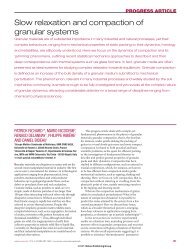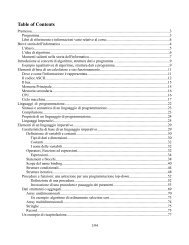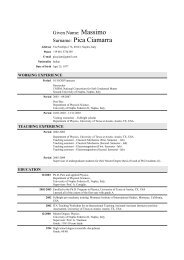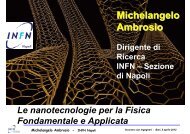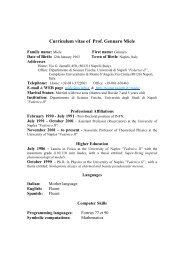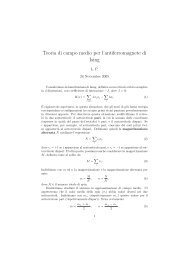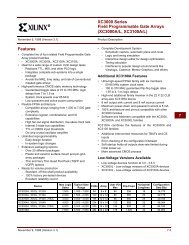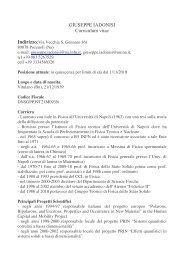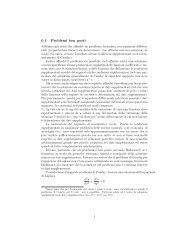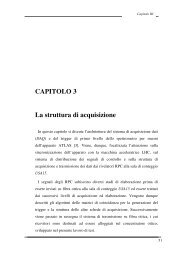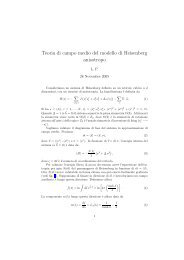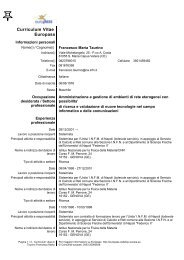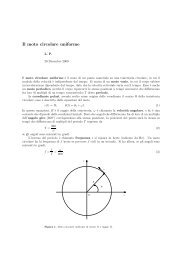Phys Rev E
Phys Rev E
Phys Rev E
Create successful ePaper yourself
Turn your PDF publications into a flip-book with our unique Google optimized e-Paper software.
MANZO et al. PHYSICAL REVIEW E 73, 051707 2006<br />
tion: a liquid crystal droplet has actually an infinite number<br />
of rotational degrees of freedom associated with changing<br />
inhomogeneous configurations of director and flow. These<br />
two rotational degrees of freedom of the droplet are always<br />
strongly interacting with each other, via viscosity, elastic<br />
forces, and possibly also photoinduced effects. This interaction<br />
may be strong enough to lock the two degrees of freedom<br />
together into a single one, so that the droplet effectively<br />
behaves as a rigid body. This is what we actually observed in<br />
our experiments. Nonetheless, by properly choosing the experimental<br />
parameters, it should be possible to reach a regime<br />
in which the two rotational degrees of freedom become<br />
effectively unlocked. We would expect that in this “unlocked”<br />
regime, photoinduced dye effects become important,<br />
even if the angular momentum exchange is entirely internal.<br />
We investigated theoretically this case and predicted the occurrence<br />
of highly nontrivial photoinduced rotational effects,<br />
which we then tried to observe experimentally.<br />
This paper is organized as follows. The general continuum<br />
theory of the light-induced dynamics of dye-doped<br />
liquid crystals is reviewed in Sec. II. In Sec. III, we then<br />
apply this theory to the case of a spherical droplet immersed<br />
in water. With the help of several strongly simplifying<br />
approximations, analytical solutions are found, predicting<br />
what should be the light-induced rotational behavior of the<br />
droplets as a function of light power and polarization and<br />
of droplet size. Our experiments are then described and<br />
discussed in Sec. IV. Our results are finally summarized in<br />
Sec. V.<br />
II. GENERAL THEORY OF PHOTOINDUCED<br />
DYNAMICS OF NEMATICS<br />
A. Dynamical fields and equations<br />
In general, the dynamics of a nematic liquid crystal under<br />
the action of laser light is defined by the temporal and spatial<br />
dependence of the following fields: i the molecular director<br />
n specifying the local average molecular alignment 12, ii<br />
the velocity vector v defining the flow of matter, and iii the<br />
electric and magnetic fields of the optical wave, E and B,<br />
respectively.<br />
The optical fields E and B are governed by the usual<br />
electromagnetic Maxwell equations in anisotropic dielectric<br />
media 13. The two material fields n and v are, respectively,<br />
governed by the director torque balance equation,<br />
d<br />
In <br />
dtn dn<br />
<br />
dt= tot 1<br />
and by the Newton equation for the acceleration or momentum<br />
conservation law,<br />
dvi dt = tot<br />
jtji , 2<br />
where j stands for the partial derivative /x j and the usual<br />
sum convention over repeated indices is understood. In these<br />
equations, tot is the total torque density acting on the molecular<br />
director, ttot is the total stress tensor associated with a<br />
fluid displacement with no director rotation this corresponds<br />
to Ericksen’s definition of stress tensors in liquid crystals<br />
14, I n is a moment of inertia per unit volume associated<br />
with the rotation of the nematic director, which is actually<br />
negligible in all practical cases it is included only for making<br />
the equation physical meaning clearer, and is the mass<br />
density, hereafter assumed to be constant incompressible<br />
fluid approximation. Moreover, in both equations above we<br />
have used the so-called “material” or “convective” time derivative,<br />
defined as d/dt=/t+v j j, corresponding to a derivative<br />
taken following the fluid element along its motion.<br />
Incompressibility actually adds the following constraint on<br />
the velocity field v:<br />
ivi =0, 3<br />
which is a particular case of the mass continuity equation.<br />
B. Constitutive equations<br />
Equations 1 and 2 are to be completed with the appropriate<br />
constitutive equations for the total torque density and<br />
stress tensor. To first order in all deviations from equilibrium<br />
and in all gradients, we may distinguish five additive and<br />
independent contributions to both the torque density and the<br />
stress tensor 14,15: hydrostatic pressure hp, elastic el,<br />
viscous vis, electromagnetic em, and photoinduced ph,<br />
the latter being that associated with dye effects. In summary,<br />
one may write<br />
and<br />
051707-2<br />
tot = <br />
4<br />
tot <br />
tji = tji. 5<br />
<br />
Each of the ten and t =hp, el, vis, em, ph terms<br />
appearing in these two equations has a well-defined firstorder<br />
constitutive dependence on the dynamical fields,<br />
which we will now briefly discuss.<br />
First, there is actually no torque density associated to<br />
pressure effects, i.e., hp =0 identically. The hp stress tensor<br />
hp<br />
term has instead the usual simple form tji =−pji, where p is<br />
the pressure field and ij is the Kronecker delta. In the<br />
incompressible-fluid approximation we are adopting, p must<br />
be treated as a pure “constraint force,” i.e., assuming just the<br />
space and time dependence needed to ensure continuous validity<br />
of Eq. 3.<br />
Next, the constitutive laws of the elastic and viscous<br />
torque densities and stress tensors are fully standard and we<br />
refer to Refs. 14 or 15 for their explicit expressions.<br />
Let us now turn to the electromagnetic terms. They are<br />
also standard, but it is nevertheless convenient to introduce<br />
them explicitly here. We assume for the time being that the<br />
electromagnetic fields present in our systems are associated<br />
only with an approximately monochromatic optical wave<br />
having a given vacuum wavelength . Let us first introduce<br />
the uniaxial optical dielectric tensor of the liquid crystal<br />
ij = 0ij + anin j, 6<br />
where 0 is the vacuum dielectric constant, the relative<br />
dielectric constant for En, and a the relative dielectric



